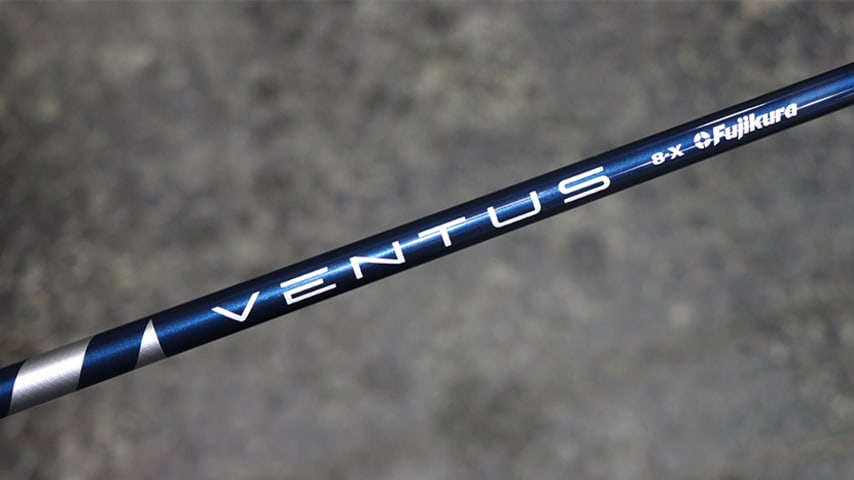Fujikura’s new Ventus shaft: Why it’s different and why it’s taking off on TOUR
14 Min Read

Fujikura’s new Ventus shaft debuted on the PGA TOUR at the 2018 Safeway Open. As of the 2019 Pebble Beach AT&T Pro-Am, there were six different players with a Ventus metalwood shaft in play. That list includes Branden Grace, who finished in second place at the 2019 Waste Management Phoenix Open with a Fujikura Ventus 6X shaft in his driver, Ben Crane (Ventus 7 driver shaft), John Huh (Ventus 6 driver shaft), Sung-Hoon Kang (Ventus 6 driver shaft), Nate Lashley (Ventus 7 three wood shaft), and Austin Cook (Ventus 7 three wood shaft and Ventus 8 five-wood shaft).
The shafts are made with a “VeloCore” designed to tighten up dispersion by reducing twist, and as Fujikura’s Fitting and TOUR Representative Marshall Thompson explains, the core actually has a multi-material bias made of stiffer and stronger materials. Recently, while on the range at the 2019 Pebble Beach Pro-Am, we went super in-depth with Thompson to figure out exactly what a multi-material bias core means, who the Ventus shafts are for, and why TOUR players have made the switch. We also touch on the challenges of getting a new shaft into a TOUR player’s bag, and how the company uses ENSO – Fujikura’s analytical computing and fitting system – to help engineer its new shafts.
Ventus shafts are currently available to the public, retailing for $350 per shaft (50-to-80 grams; R2, R, S and X flexes). Enjoy the full Q&A below!
PGATOUR.COM: What is the Ventus shaft?
THOMPSON: Ventus is a brand new design for us, which has been unbelievable. We threw a lot of technology into it. VeloCore, for one, which is ‘Velocity at its core.’ And we’ve just found that ball speeds were much faster because you were able to hit the center of the face more consistently – horizontal and vertical impact locations significantly improved. That was due to the design.
What we did was we have a multi-material bias core, which is made up of a Pitch 70 Ton (Carbon Fiber) material that is three times stiffer than your standard mod. I think it’s 150 percent stiffer than T1100 G, which we’ve used on products in the past. It also has an HR-40 Ton material. What we did was we put those materials on the bias sheet. What I mean by the bias sheet… that’s a 45-degree angle. So you have material that runs down the length of the shaft at zero degrees, and that effects bending, and then you have the bias sheet, which runs at 45 degrees and effects torsional or twisting of the club head. So by having the Pitch 70 Ton, which is three times stronger than your standard mod, mixed in with that HR-40, there’s just less twisting going on with the club face, especially through impact. We found off-center hits to have faster ball speeds, and people were wearing out the center of the face. You’re also getting an extremely stable tip section as well, so it’s going to help with launch and spin and it’s going to eliminate some droop. And then you’re also getting an accelerated taper rate in the handle, so you’re going to get a little bit more feel. You’re not only going to be able to load the product efficiently, but you’re going to hit center face and get more ball speed.
It’s been a wonderful design. We’ve seen a lot of guys test it out here, and we’re only a few weeks into the season, but I think last week (at the 2019 Waste Management Phoenix Open) we had six in play.
PGATOUR.COM: You talk about the fingerprint or the thumbprint, who is this shaft right for? What golfer should be looking at or testing this shaft?
THOMPSON: Somebody who doesn’t load it very aggressively from the top, they could benefit by storing a bit more energy, having that accelerated taper rate, a little bit smoother handle, they’ll be able to load that product more efficiently and still get the control and stability down below. Anybody looking for that mid-launch, mid-to-low spin, I think the Ventus is going to be unbelievable for them. I think they’re going to have a lot of success. I think if somebody is face mapping it and hitting it heel-side or toe-side, I would say give Ventus a shot because on all of our data, I would say upwards of 80-to-90 percent of people had an easier time hitting the center of the face, and that’s the most important part of the fitting process. I think it can benefit all golfers, I really do.
PGATOUR.COM: You said there were six in play last week (at the 2019 Waste Management Phoenix Open), what are they seeing in terms of performance, ball speed improvements, loft, spin… how is the shaft effecting their flights?
THOMPSON: From what I’ve seen, compared to, lets say a player was using Atmos Black, which is a low launch, low spin product with a stiff handle, they’re definitely getting a little bit more feel in the handle. And, they were getting a little bit more launch and a little bit more spin coming from that Atmos Black. As heads and CG (center of gravity) keeps changing, and it seems like heads are lower and lower spinning today… Ventus is not a super low-launch, low-spin product. It allows you to get a little bit more spin, it allows the ball to get up in the air nice and high, and I think they got a little bit more launch and spin, which helped launch conditions because they were able to carry it a little bit further. When they were getting back to maybe courses that were running hard, firm and fast, maybe they might take a little loft off, or maybe try a little stiffer tip to bring the descending angle down just a little bit, but it’s really worked well for a lot of these wet courses, because it’s keeping that ball in the air.
PGATOUR.COM: Watching a bit of shaft testing yesterday (on the range at the 2019 AT&T Pebble Beach Pro-Am), Ben Crane, as I gathered, was averaging about 163 mph of ball speed with his previous gamer, and then he switched over to the Ventus and he was up at 170 ball speed. That’s a pretty crazy improvement, what do you attribute that to?
THOMPSON: And that’s a number that he hasn’t seen, ever maybe, or in a very, very long time. He kind of wears out that 162-163 ball speed, and when he was testing in Oceanside, just like he is at Pebble, he was able to get it up to 170 ball speed, which is his fastest. He’s excited. He saw center face contact go up, and he was loading it a little bit more efficiently, but he was also getting more control and stability because of that stiff tip section. Yea, he picked up his fastest ball speed he’s seen ever. So that’s exciting for us. When we see a player gain 1 or 2 mph that’s big, but to see someone like him gain 6 or 7 mph that’s a game changer. He’s going to have to relearn how to hit his wedges again (laughs). You know, you have shorter clubs coming in, he’s going to score better. I think that’s exciting. And the fact that it’s been cold (temperature wise), you might even see that number increase a little bit as it gets a little bit warmer and they get back to Florida.
PGATOUR.COM: Take me back a bit to the development of the shaft. What goes into that, and how does ENSO get used in the process?
THOMPSON: Yes, so ENSO is nice because… we use the term, it’s like an MRI for a golf shaft. We’re able to see how that shaft is bending, deflecting and twisting prior to impact. [Ventus] started with an idea that we wanted something extremely stout and stiff, almost like a little spike on the EI (elongation index) curve profile that we’re looking at in the tip section. And we wanted to make sure the player still had that ability to load the product, because starting back with our Pro (series) a couple years ago, we noticed that most amateurs and even TOUR players, they don’t load the golf shaft nearly enough. So that’s why we started creating in those Pro shafts softer handle section, which gave them the ability to do that. And then we mixed in the accelerated taper rate, which gives you a little bit smoother profile towards that handle section and it allows the player to load it a little bit. And then we started messing around with… we get new materials that come across our desk all the time, and we found one that we liked in this Pitch 70 Ton. We had this idea to put it on the bias layer, which is going to eliminate some twist. Due to a lot of our ENSO testing, we wanted to have something that didn’t twist as much through the impact area, and having that Pitch 70 Ton, which is three times stronger than your standard mod, mixed in with the HR-40, it did its job.
It’s not just one design, it’s multiple designs that we create and then we settle on one that’s giving us the best performance. And it’s all proven through ENSO. To have that ability to see what a shaft is doing through impact, that’s a shaft designers dream. So our engineering department has done a fantastic job. We’re always learning from ENSO, and finding out all these different swing profiles and seeing what parts of the shaft effect the ball going more right or more left or higher or lower, or increase or decrease in spin. And I feel like we hit a homerun with this shaft. I really do.
PGATOUR.COM: What shaft in the previous lineup would you compare this shaft to… who would you recommend to upgrade their shaft and go into this?
THOMPSON: You know, I think it’s a unique profile in the fact that we haven’t had a multi-material bias core in the past. But I think that anybody who was originally playing our Pro series shafts would benefit from this product because you’re still going to get that feel in the handle that you’re used to, and a little stable mid-tip section, but less twist and more center face contact. And everybody’s looking for that. I think if you’re playing the Pro, or even a Speeder Evolution 3 and 4, which have an extremely smooth feel to them, I think you’re going to get that same feel in the handle. But you’re getting the benefits of an ultra-stiff tip and less twist. Whatever’s going to get you to find the center of the face more efficiently, that’s what we’re trying to do.
PGATOUR.COM: How does tipping affect a shaft such as this, given the intent of the design?
THOMPSON: It still has a 2.5-inch parallel tip section so you can still tip it. Out here, on TOUR, it’s usually a 1-inch tip is standard to stabilize that profile a little bit for them. I don’t like going above an inch, just because you start getting into the mid-section of that shaft and you’ve totally taken out what that tip was designed to do. So I think we get a little tip happy sometimes out here, we start trimming, but when you’re working with guys who are swinging it as fast as they are, 120 mph, they have to have something that feels very stable to them. So I would say you can get away with an inch tip. You’re not affecting the design, you’re tightening it up, you’re stiffening it up a little bit. One inch equals one flex, or ten cycles (CPMs). Anything more than that I think is unnecessary.
PGATOUR.COM: Say in a year’s time, do you see Ventus being the big name shaft for Fujikura out on TOUR?
THOMPSON: I do. I think it’s something like Atmos that when we started this line, we had one in play at the Sony, then by the time we got to the Honda, there were like 25 Atmos shafts in play. It takes time to get the seeding right and get players to test it, and you never know what kind of weather you’re going to get on the West Coast. A lot of people say the real fitting starts when you get to Florida. But we’re already seeing that growth happen. With six shafts in play last week (at the 2019 Waste Management Phoenix Open), and then we’ve got the WGC events and we’re going to be in Florida soon, you’re going to see a decent amount of these in play. I think you’re going to see it take off. And Atmos has been a product that has grown every single year out on TOUR. We’re 3-4 years into it, and we had 60 percent growth with Atmos last year. I think Ventus is going to take on that similar path; it’s going to explode. Guys are going to be hitting it and seeing the results, like we talked about Ben Crane earlier. Guys are looking for that, and I think it’s going to take off and that’s great. It’s not going to stop us from trying to develop the next best thing after Ventus. We’re doing our homework, we’re seeing how this product fits and how it’s working on TOUR, and for the general consumer level. We’re passionate about what we do, and we’re constantly going to have new ideas that keep evolving, and we’re going to keep having new materials that come across our desk. We make the best product. In my head, we make a darn good product that fits a lot of players, and we’re only getting smarter and more efficient at the way we do things. But I see Ventus being in our lineup for a long time because it has a lot of tech that went into it, expensive materials that went into it, and we’re excited.
PGATOUR.COM: Is it a challenge where… we’re at a TOUR event. There’s TOUR trucks and there’s TOUR reps circling the range. Is it a challenge to get players to try Ventus for that first time?
THOMPSON: You know, it is. I like to work with the OEM reps as much as possible because I don’t want to infringe upon anything they’ve been working with a player on for awhile. And they haven’t seen the new shaft, they don’t know what it does. They haven’t worked enough with it. So, it’s that initial… once we talk to the reps and their players struggling and we think we have a good part that might match up to him. And if it is Ventus, we’ll get it out there and we’ll test it. And then the rep will see for himself what’s going on, and then next thing you know, every player that’s thinking about testing a new product, he has a Ventus in his hand, you know, or some other Fujikura. And that was the thing, I think we started stressing out because we didn’t see a lot of them in play the first couple weeks, and then by the time we got here (at Pebble Beach) I’ve seen every single OEM rep when someone is doing some shaft testing giving Ventus a shot. It’s something that’s going to keep growing, and as the reps get a little bit more familiar with what it does, they see the success players are having with it, it’s going to be good.
PGATOUR.COM: And it’s one of those things, as with different putters or different drivers or whatever the case may be, that once the players see other people using the shaft, it kind of has that Domino effect.
THOMPSON: Oh, 100 percent. Or maybe two guys that play for the same company, they go out and play a round and somebody’s striping it or hitting it really well, they go ‘What is that? I want to hit it.’ Next thing you know, they’re wanting one built up too. So you get some in play like that, you get some in play through the reps, or you get some in play through the relationships we have. It’s just something that’s going to explode out here on TOUR, I know it. I’m excited to see where it’s going. We’ve gotten a lot of good feedback. We’re going to crush it.












